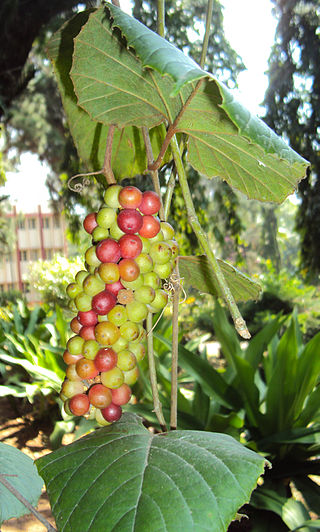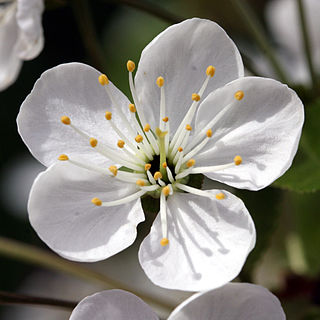
The Malpighiales comprise one of the largest orders of flowering plants, containing about 36 families and more than 16,000 species, about 7.8% of the eudicots. The order is very diverse, containing plants as different as the willow, violet, poinsettia, manchineel, rafflesia and coca plant, and are hard to recognize except with molecular phylogenetic evidence. It is not part of any of the classification systems based only on plant morphology. Molecular clock calculations estimate the origin of stem group Malpighiales at around 100 million years ago (Mya) and the origin of crown group Malpighiales at about 90 Mya.

Saxifragales is an order of angiosperms, or flowering plants, containing 15 botanical families and around 100 genera, with nearly 2,500 species. Of the 15 families, many are small, with eight of them being monotypic. The largest family is the Crassulaceae (stonecrops), a diverse group of mostly succulent plants, with about 35 genera. Saxifragales are found worldwide, primarily in temperate to subtropical zones, rarely being encountered growing wild in the tropics; however, many species are now cultivated throughout the world as knowledge of plant husbandry has improved. They can be found in a wide variety of environments, from deserts to fully aquatic habitats, with species adapted to alpine, forested or fully-aquatic habitats. Many are epiphytic or lithophytic, growing on exposed cliff faces, on trees or on rocks, and not requiring a highly organic or nutrient-dense substrate to thrive.

Geraniales is a small order of flowering plants, included within the rosid subclade of eudicots. The largest family in the order is Geraniaceae with over 800 species. In addition, the order includes the smaller Francoaceae with about 40 species. Most Geraniales are herbaceous, but there are also shrubs and small trees.

Nyssaceae is a family of flowering trees sometimes included in the dogwood family (Cornaceae). Nyssaceae is composed of 37 known species in the following five genera:

The Myricaceae are a small family of dicotyledonous shrubs and small trees in the order Fagales. There are three genera in the family, although some botanists separate many species from Myrica into a fourth genus Morella. About 55 species are usually accepted in Myrica, one in Canacomyrica, and one in Comptonia.

Putranjivaceae is a rosid family that is composed of 218 species in 2 genera of evergreen tropical trees that are found mainly in the Old World tropics, but with a few species in tropical America.

Cissus is a genus of approximately 350 species of lianas in the grape family (Vitaceae). They have a cosmopolitan distribution, though the majority are to be found in the tropics.

Parthenocissus, is a genus of tendril climbing plants in the grape family, Vitaceae. It contains about 12 species native to the Himalaya, eastern Asia and North America. Several are grown for ornamental use, notably P. henryana, P. quinquefolia and P. tricuspidata.

The rosids are members of a large clade of flowering plants, containing about 70,000 species, more than a quarter of all angiosperms.

The Muntingiaceae are a family of flowering plants, belonging to the rosid order Malvales. The family consists of three genera: Dicraspidia, Muntingia, and Neotessmannia, each with a single species. They are woody plants of the tropical regions of America. The older Cronquist system placed these genera in the family Tiliaceae, with which they share morphological similarities, but have no evolutionary affinity. Muntingia calabura is widely introduced in tropical regions, because of its edible fruit. Dicraspidia donnell-smithii and Neotessmannia uniflora are the other two species in the family, the latter only known from herbarium specimens.

Huerteales is the botanical name for an order of flowering plants. It is one of the 17 orders that make up the large eudicot group known as the rosids in the APG III system of plant classification. Within the rosids, it is one of the orders in Malvidae, a group formerly known as eurosids II and now known informally as the malvids. This is true whether Malvidae is circumscribed broadly to include eight orders as in APG III, or more narrowly to include only four orders. Huerteales consists of four small families, Petenaeaceae, Gerrardinaceae, Tapisciaceae, and Dipentodontaceae.

Tetrastigma is a genus of plants in the grape family, Vitaceae. The plants are lianas that climb with tendrils and have palmately compound leaves. Plants are dioecious, with separate male and female plants; female flowers are characterized by their four-lobed stigmas. The species are found in subtropical and tropical regions of Asia, Malaysia, and Australia, where they grow in primary rainforest, gallery forest and monsoon forest and moister woodland. Species of this genus are notable as being the sole hosts of parasitic plants in the family Rafflesiaceae, one of which, Rafflesia arnoldii, produces the largest single flower in the world. Tetrastigma is the donor species for horizontal gene transfer to Sapria and Rafflesia due to multiple gene theft events.

The genus Cayratia consists of species of vine plants, typical of the tribe Cayratieae. Some of them are useful, and they are found in tropical and subtropical areas of Asia, Africa, Australia, and islands of the Pacific Ocean.

Ampelocissus is a genus of Vitaceae having 90 or more species found variously in tropical Africa, Asia, Central America, and Oceania. The type species, A. latifolia, was originally treated under its basionym, Vitis latifolia, and was collected from the Indian subcontinent.

Huaceae is a family of plant in the rosids group, which has been classed in the orders Malpighiales, Malvales, and Violales or in its own order Huales. The APG II system placed it in the clade eurosids I, whereas the APG III system of 2009 and APG IV (2016) place it within the Oxalidales. The family is endemic to central Africa. It contains four species in the following two genera:
Pterisanthes is a vine plant genus in the subfamily Vitoideae. Its native range is Indochina to W. Malesia including the Philippines. The relationship between Pterisanthes and another genus "Nothocissus" with Ampelocissus has been debated, with the latter now subsumed within Ampelocissus, but with Pterisanthes retained.

The superrosids are members of a large clade of flowering plants, containing more than 88,000 species, and thus more than a quarter of all angiosperms.

In phylogenetic nomenclature, the Pentapetalae are a large group of eudicots that were informally referred to as the "core eudicots" in some papers on angiosperm phylogenetics. They comprise an extremely large and diverse group accounting for about 65% of the species richness of the angiosperms, with wide variability in habit, morphology, chemistry, geographic distribution, and other attributes. Classical systematics, based solely on morphological information, was not able to recognize this group. In fact, the circumscription of the Pentapetalae as a clade is based on strong evidence obtained from DNA molecular analysis data.

The Cayratieae is one of five tribes of vine plants that are now recognised in this subfamily Vitoideae. It contains genera restored or newly erected from species in the previously configured genus Cayratia, which was found not be monophyletic:.






















